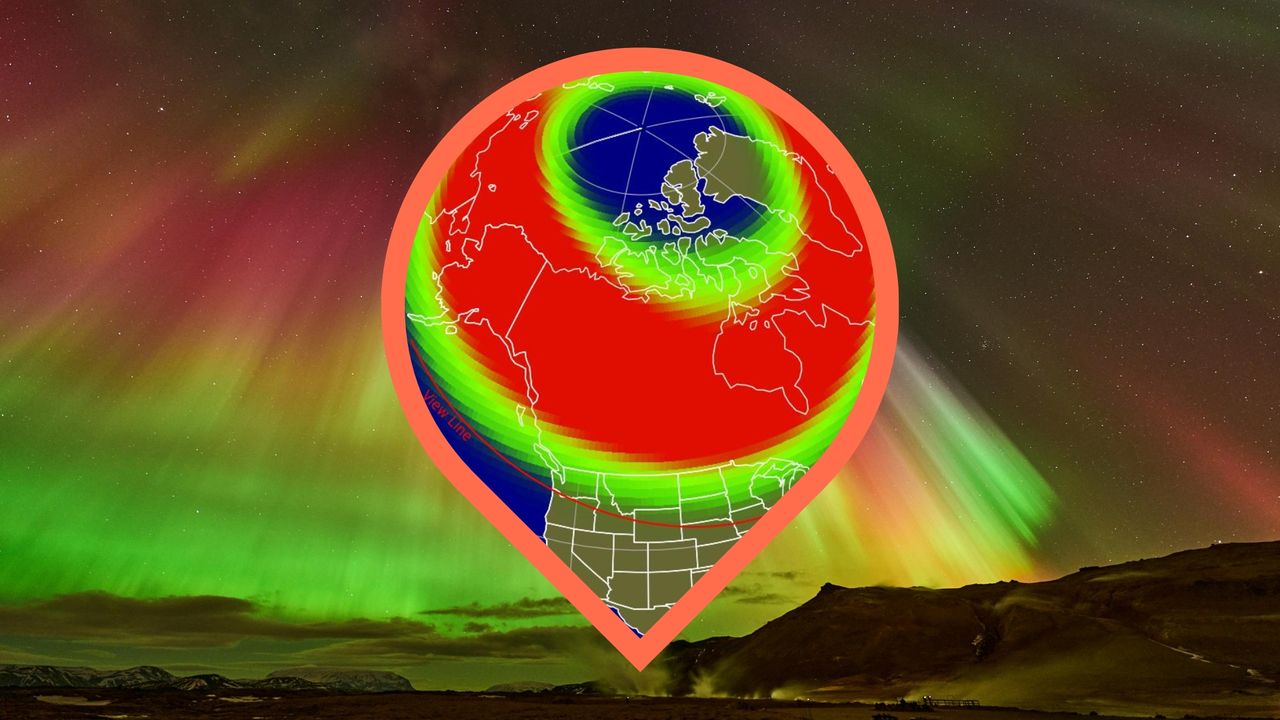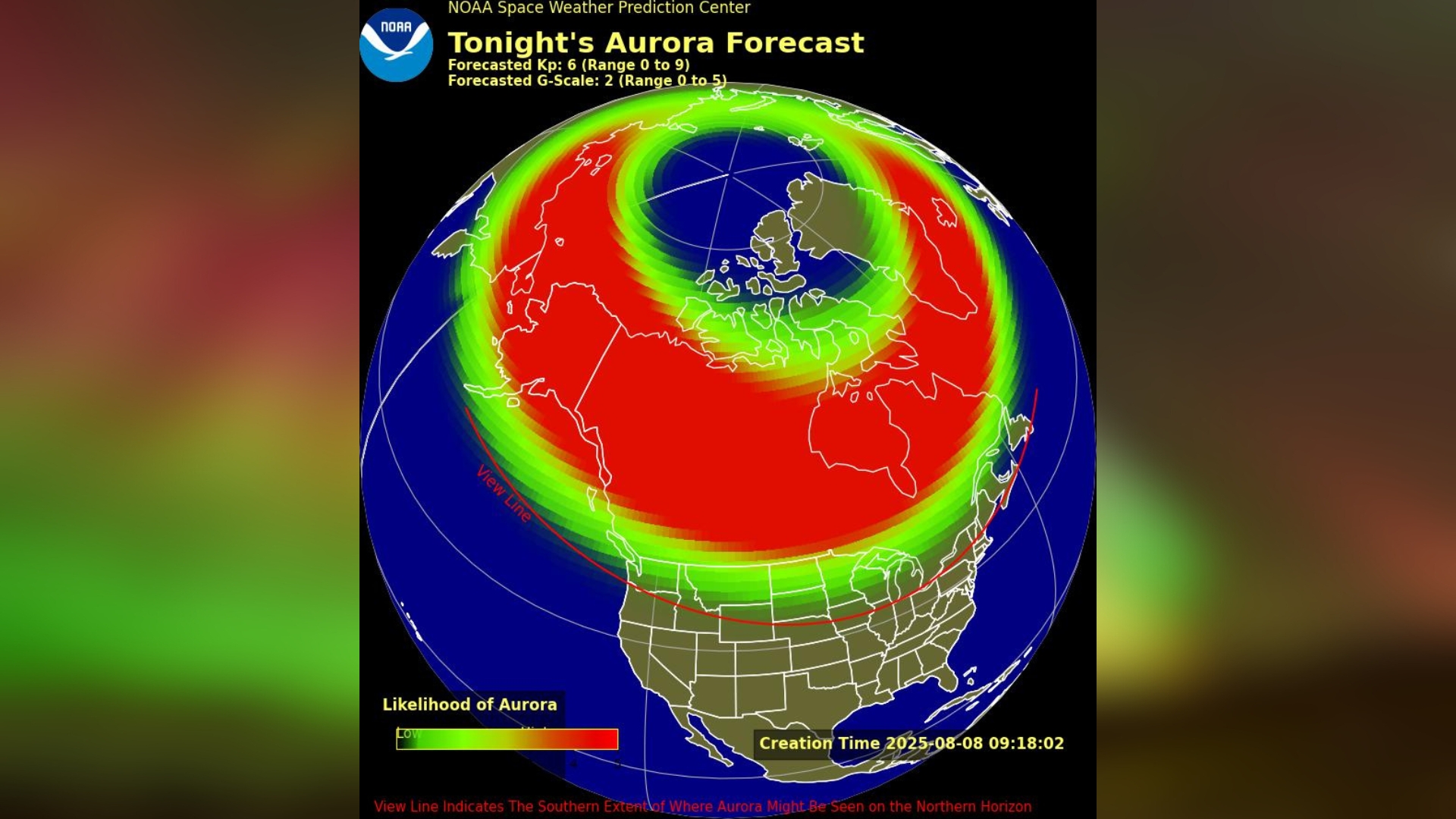
Heads up aurora chasers! The northern lights could illuminate skies overnight on Aug. 8-9 as an incoming coronal mass ejection (CME) and speedy solar winds may spark geomagnetic storm conditions, according to the National Oceanic and Atmospheric Administration (NOAA).
Though only a glancing blow is predicted from the CME, any impact could disrupt Earth's magnetic field, which in turn can trigger geomagnetic storms and impressive auroras.
Space weather forecasters from NOAA's Space Weather Prediction Center (SWPC) and the U.K. Met Office predict a chance of minor (G1) to moderate (G2) geomagnetic storms, with the latest NOAA forecast dialing activity down slightly to G1 conditions (Kp 5). That still means there's a window of opportunity for aurora sightings at northern latitudes, weather and dark skies permitting.
When will the geomagnetic storm hit?
The exact timing of the CME's arrival and whether it will spark significant geomagnetic storming remains uncertain.
Solar physicists initially predicted a glancing blow from the CME released on Aug. 5, but the solar wind remains quiet and the impact has yet to arrive. Both NOAA and the U.K. Met Office now anticipate the CME will arrive sometime around 8 a.m. EDT (1200 GMT) on Aug. 8, but confidence in this timing remains low. A geomagnetic response is still possible if the CME has the right magnetic orientation, but there’s no guarantee it will spark strong auroras.
NOAA's updated Kp index forecast shows geomagnetic activity peaking at Kp6 (G2 – Moderate storm) between 5:00 a.m. and 8:00 a.m. EDT (0900–1200 GMT) on Aug. 8. Conditions may then ease slightly but are forecast to intensify again to Kp5 (G1 – minor storm) between 8:00 p.m. and 11:00 p.m. EDT (0000–0300 GMT on Aug. 9). That means auroras could still be visible across the northern U.S. during the night of Aug. 8–9, depending on when the CME actually hits and whether it carries the right magnetic orientation to spark storming.
The Kp index, which ranges from 0 to 9, is used to measure geomagnetic activity. Higher values mean auroras are more likely to be visible at lower latitudes (further from the poles), including parts of the northern U.S.
The U.K. Met Office also forecasts enhanced aurora activity overnight, Aug. 8-9, due to the possible impact from the CME and fast solar wind currently spewing out of a coronal hole on the sun.
Where are the northern lights visible tonight?

Based on the NOAA forecast, we've listed 18 U.S. states that appear fully or partially above the aurora view line Aug. 8-9. While the auroral oval has shifted slightly north compared to earlier forecasts, the same 18 states remain within the zone where auroras may be visible if storm conditions materialize.
They are approximately ordered from most likely to least likely to see the northern lights based on their proximity to the aurora oval's center and how much of each state is within or near the view line.
States that could see the northern lights tonight
- Alaska
- Montana
- North Dakota
- Minnesota
- Wisconsin
- Michigan
- Maine
- South Dakota
- Vermont
- New Hampshire
- Idaho
- Washington
- Oregon
- New York
- Wyoming
- Iowa
- Nebraska
- Illinois
But remember, auroras are fickle; sometimes they appear much farther south than predicted, and other times they barely show up at all. Many conditions have to align for the perfect display.
Northern Hemisphere aurora forecast courtesy of the Met Office
How can I see the northern lights from where I live?
If you live in one of the 18 U.S. states forecast to potentially catch a glimpse of the northern lights tonight, there are a few things you can do to give yourself the best chance of seeing them.
First, find a north-facing vantage point with a clear view of the horizon, as far away from light pollution as possible. The best time to look for the northern lights will be around 2 a.m. local time, due to the limited hours of darkness in the summer months. However, since the solar storm could arrive at any time, it's worth keeping an eye on the skies as soon as it gets dark.
We recommend downloading a space weather app that provides aurora forecasts based on your location. One option I use is "My Aurora Forecast & Alerts," available for both iOS and Android. However, any similar app should work well. I also use the "Space Weather Live" app, which is available on iOS and Android, to get a deeper understanding of whether the current space weather conditions are favorable for aurora sightings.
Editor's note: This article was updated at 5:15 a.m. EDT (9:15 GMT) Aug. 8 to reflect the latest space weather forecasts from NOAA and the U.K. Met Office. The predicted geomagnetic activity has been slightly reduced, with NOAA now forecasting a peak at G2 (Kp6) early on Aug. 8 and a secondary Kp5 window later that night. Aurora visibility remains possible across the northern U.S., depending on the CME’s timing and impact.







